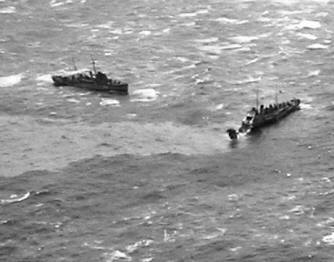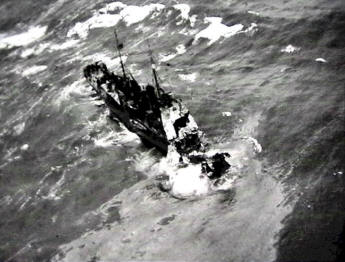Source: Report of HMS Speedwell Public Records
Office ADM 1/10785
REPORT ON THE
SINKING OF HMS SPHINX
On the
morning of Saturday 3rd February 1940 HM Ships Sphinx,
Speedwell and
SKIPJACK
were in the
position 57° 37’ north, 1° 59’ west, carrying out a searching sweep.
Ships were in ‘H’ formation, line abreast to port, in order Sphinx,
Speedwell,
SKIPJACK,
five cables apart with both sweeps out. Course was 017 degrees,
speed 11 knots giving maximum speed through the water of six knots.
Weather
conditions were: Wind SSE force 5, sky overcast with low
cloud.
At 0915
two aircraft were sighted to the southward. They were challenged and
as no reply was received were assumed to be the enemy. The aircraft
were flying at a height of about 1,000 feet, steering a northerly
course. They resembled the Dornier DO17 type.
A few
minutes after the first aircraft were sighted a third machine,
unidentifiable, was sighted 3 or 4 miles to the northward flying
very low, (50 – 100 feet). This machine turned away almost at once
and was not subsequently seen again.
At about
0918 the two Dorniers carried out a glide bombing attack on Sphinx
in line astern formation approaching her from aft at a height of
about 1,000 feet, descending to about 300 feet. One bomb was seen to
be dropped by each machine at the bottom of the glide. One bomb
missed ahead and to port, failing to explode, the other hit Sphinx
but did not appear to explode until several seconds after hitting
her It is understood that this bomb passed down through the bridge
and upper deck, exploding in the fore mess deck. Both these bombs
appeared to be large ones. As a result of the explosion the whole of
the fore part of Sphinx, between the bridge and stem, was destroyed.
The upper deck of the forecastle was folded back against the bridge.
The stem piece and keel held till some hours after.
Fire was
opened by all ships on attacking aircraft immediately before the
first bombing attack.
After
delivering the first attack the aircraft circled round to the east,
gaining height, and approaching from the southward delivered a
second attack on Sphinx. Each plane dropped one bomb, which seemed a
large one. One of these bombs missed ahead and to port , about 100
feet away, and exploded under water with much the same effect as a
depth charge exploding at a depth of 100 feet. The other bomb fell a
few feet away from Sphinx, and astern, failing to explode.
Subsequently the aircraft split up and carried out individual
bombing and machine gunning attacks on both Sphinx and
SKIPJACK.
Two more bombs were dropped at Sphinx but both missed, one ahead and
one astern about 100 feet, both failing to explode.
Three
separate attacks were made on
SKIPJACK,
the first and last from aft and the second from ahead, with
intervals of about five minutes between attacks. In the first attack
two bombs were dropped, one large and one small, both missed on
either quarter at about 10 feet distance. In the second attack one
small bomb was dropped which missed about 30 feet on the starboard
bow. Each attack on
SKIPJACK
was
accompanied by intense machine gun fire, the ship being repeatedly
hit though no casualties were sustained.
Two or
three machine gun attacks were made on Sphinx, all from aft. These
alternated with the attacks on SKIPJACK. It is understood that
casualties on Sphinx were four dead (killed by bomb explosion) and
three injured, two by bomb explosion and one by machine gun fire.
No
determined attack was made on Speedwell though toward the end of the
raid one aircraft approached from astern, as if to carry out an
attack. This machine was seen to be hit by 0.5” machine gun fire
from Speedwell, it then turned away and dipped sharply. Black smoke
was seen coming from this machine somewhere amidships.
SKIPJACK
reports that she hit one machine during the third
attack on her, probably with 0.5” machine gun or Lewis gun fire and
that white smoke could be seen issuing from her.
Both
planes flew away to the eastward at about 0940.
The
following avoiding action was taken during the attacks. Speedwell:
Both sweeps were cut at the outset and the course was frequently
altered.
SKIPJACK
was hove up and the ship steered a zigzag course.
During the
attack, fire was kept up on the enemy planes with 4", 0.5" and Lewis
guns whenever the guns would bear or aircraft were in range.
Speedwell's foremost 4” gun was out of action after firing two
rounds, due to a defect in the recuperator. Fire in Speedwell and
SKIPJACK
was in quarters firing throughout, using fuze setting
‘2’ (short barrage).


HMS Sphinx
Sphinx was
taken in tow stern first by Speedwell at 10.50. Considerable
difficulty was experienced in passing the tow owing to the state of
the sea. Course was shaped w230 degrees and speed was gradually
worked up to 110 revolutions giving approximately 3 knots It was
intended to get under the lee of Kinnaird Head. The tow was
proceeding easily until 1250 when the 31/2” wire parted.
SKIPJACK,
who was in company, was ordered to take Sphinx in tow and tow was
passed at 1500. At 1800 course was altered to 280 degrees in order
to close the land more quickly. Tow proceeded easily, speed about
two knots. At 1315 contact was made with HM Ships Boreas and Brazen.
They were asked to stand by in case assistance was required and they
proceeded to screen the ships of the 5th MSF at 1905
contact was made with HMS Harrier who had come from Invergordon to
assist.
At 2200
the tow parted and SO 5th in Harrier was informed.
Harrier then attempted to take Sphinx in tow but this was
unsuccessful. At 0100 a signal was intercepted from Sphinx asking
for a ship to go alongside to take off the wounded. Speedwell was
the nearest ship and made two attempts but owing to the heavy seas
and danger of sinking Sphinx, the attempt was abandoned. Sphinx
appeared to be floating well and reported that she was comfortable.
At 0245
Harrier again attempted to get a wire to Sphinx in order to hold her
stern to wind. Speedwell and
SKIPJACK
were
ordered to form a lee.
At 0300
information was received from Harrier that Sphinx was going to
abandon ship and Speedwell was told to go alongside her. The first
attempt was made at 0316. This failed, a second attempt was made
immediately after and four men were taken off Sphinx. A third
attempt to get alongside was made at about 0333, but this failed. It
was then seen that Boreas was standing by to go alongside Sphinx and
Speedwell then lay off to give her room. Boreas made repeated
attempts to get alongside Sphinx and it is understood that she was
able to take off a few men.
At about
0445 Sphinx capsized and a search for survivors was made until
daylight. Three men on a Carley float were picked up by Speedwell
but no further survivors were seen.
Throughout
the night the weather deteriorated considerably and at the time when
Sphinx capsized the seas were very high and a full gale was
blowing.

